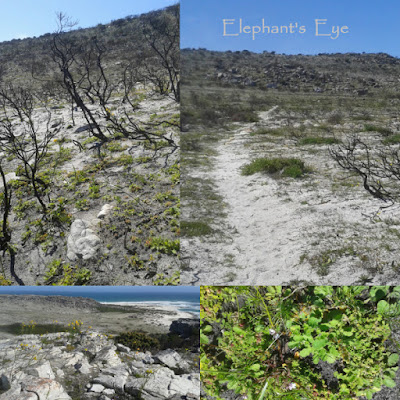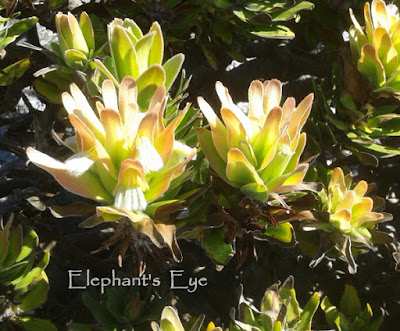Shipwreck Trail at Cape Point
By Diana Studer
- gardening for biodiversity
in Cape Town, South Africa
We came to live in False Bay to hike at Cape
Point and, since last November, this is the first time we did. It was a
clear and very windy day last week. Yesterday a lightning strike started
another fire
above Simon's Town. Today's gentle soaking rain has ended that fire.
The Shipwreck Trail circles around along the beach then up
to the ridge. Head down into the wind. Next time, we'll try circling the other
way with windblown sand NOT in our eyes.
We were impressed by this family of Egyptian geese foraging along the shore. Five long leggedy teenagers swept up the rocks by each breaking wave. They landed a little higher, shook out their winglets and carried on regardless. The parents fly to a higher perch.
The Ungardener went down to the Nolloth shipwreck. The ship
struck Albatross Rock and went aground in 1965. Both the crew and the cargo
were rescued. Must be epic waves as there were a group of surfers in Olifantsbos Bay.
I slowly continued to where the path turns up away from the
beach. I went very slowly, we haven't hiked since Agulhas
in August, then a LONG sedentary stretch in Porterville as we waited to sell
the house. But last September we did get to the Sevilla
Rock Art Trail and also Postberg
and Darling. Last August was the last time we hiked
in the Groot Winterhoek. Walking against a fierce wind, which almost,
lifted me off my feet, makes very tired. Then I saw a group of 5 bontebok,
kindly arranged across Here's The Path. I sat for a while on the path and
watched them grazing on the fresh green. Also after the sad tortoises who
didn't survive the fire, it was a joy to see two nibbling their way along.
The buck with one horn we saw from the car as we drove back
to the gate.
This combination of fire
in March, and winter rain in between, meant fire
flowers and good grazing. That patch of green is approximately what one
foot would destroy by not keeping to the paths, as we are asked to. Annuals and
bulbs seizing their chance, shrubby proteas getting the next generation
established.
Fynbos ecologist Tony Rebelo said that before the recent finds, this morel mushroom had been seen on the peninsula only about twice in the last 10 years. “A lot has come back, but the big [flower] displays we are likely to see next spring.”
 |
| Recovery after the March fire That patch bottom right is aproximately what one footstep would destroy off the path |
That slope we climbed was scattered with yellow and a few
orange tall flowers Moraea ochroleuca
which blooms 'mainly after fire'. Dancing in the wind and tricky to capture!
We walked along the ridge named for the protea bushes.
Pagoda flower Mimetes.
I walk slowly, since even in this fire scathed landscape
there is a huge variety of flowers. Delicately marked purple and white Babiana. Cobalt blue Lobelia. Just above the sand a tiny
yellow wild iris Moraea. Lying on the
sand an apricot Oxalis. Tucked in a
sandy crevice between the rocks on the shore a yellow daisy.
At the end of the trail a steep path zigzags down among the
rocks, and flowers. With a view across Schuster's Bay to Platkop and off to the
left Slangkop lighthouse at Kommetjie.
As we drove back to the gate we stopped to watch a family of
zebras. I think this is a half-grown young one.
Home via the Good Hope Nursery, where I
collected a Pelargonium
fulgidum and an Adenandra for
my blue pot.
Pictures by Diana and Jurg Studer
of Elephant's Eye on False Bay
(If you mouse over teal blue text, it turns seaweed red
Those are my links.
To read or leave comments, either click the word Comments below,
or click this post's title)
Pictures by Diana and Jurg Studer
of Elephant's Eye on False Bay
(If you mouse over teal blue text, it turns seaweed red
Those are my links.
To read or leave comments, either click the word Comments below,
or click this post's title)










What a lovely place to be able to hike and it is interesting to see plants that I grow, mainly in my greenhouse, in the wild. Love the baby zebra
ReplyDeleteWhat a lovely way to spend the day. I know how devastating at first fires can be, but in their aftermath, everything is renewed. We've had several wildfires over the past several years. Today these areas are still recovering but in such a beautiful way. Nice Egyptian Geese!!! Very cool birds!
ReplyDeleteThank you for sharing this lovely hike. It was a real treat.
ReplyDeleteHappy Spring ~ FlowerLady
That would definitely be a spot I would want to explore in South Africa! Hikes near waterways are always full of life. I don't recall hearing of a Bontebok before--a type of antelope, I guess? Beautiful!
ReplyDelete'bont' meaning pied
Delete... Glory be to dappled things ...
and yes, an antelope, quite large.
What a treat to walk with you and see the flowers with your knowledgeable eyes. I look forward to the spring bonanza which will follow the fire season.
ReplyDeleteGreat to see the geese. I didn't realise that zebra range so far south. You are surrounded by fabulous flora and fauna!
ReplyDeleteWhat an adventure to hike there!
ReplyDeleteThe Egyptian geese are here abundant as well, at every park lake and I even saw them on top of the buildings in the middle of Frankfurt.
Fantastic, great adventure - but that's what I love! You should get money from the tourist office for your posts!!! Great.
ReplyDeleteNo, I'm not cooking all year long on the wood stoven - only during the colder season. Hate to clean the ceramic glass cooktop every single minute :)!!!
All my best to you my friend and happy days
Elisabeth
Diana what a gorgeous walk, and a real live zebra? We certainly don't come upon those too often...I love their stripes.
ReplyDeleteIt's so interesting to see the Babiana....it's considered a collectors kind of bulb here, not every store carries it. Beautiful.
Jen
What a beautiful place. It amazes me what a fire can do. It seems like it does so much damage, but then it also creates opportunity and life for some species. Some lovely botanical finds!
ReplyDeleteI've just learnt that there's a fire asparagus (fern) which blooms 2 weeks!! after a fire, with flowers to feed the bees.
DeleteYou live in such a magical place. So unique and so interesting. Those sweet little blossoms making their faces shine in the sunlight, and oh to be able to see that Zebra in it's own natural habitat. Heaven.
ReplyDeleteBig Texas Hugs,
Susan and Bentley
I think those teenage geese may have been playing in the waves! I could almost feel the sandy wind blowing in your face as you made your way. It is amazing what lovely flowers come from the fire scorched earth.
ReplyDeleteSeeing the baby Zebra is great! Wildflowers and plant growth is quite a benefit after the cleansing of fire.
ReplyDeleteYour first hike in the place you moved to do more of - sounds like me. I have a national park just 90 minutes east, plus many others nearby, and I hardly go to those.
Zebras so close...wow. And I love how nature is resilient sending up flowers after a fire. Not to mention a trail where you can see shipwrecks...so cool!
ReplyDeleteAn inspiring walk followed by a stop for plant purchases seems like a formula for a great day. :-) -Jean
ReplyDelete